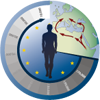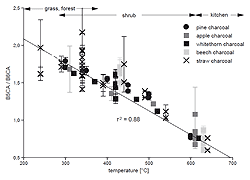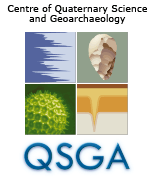- Lab experiments revealed high correlation of molecular markers extracted from chars in relation to fire temperature (r2 = 0.88; see Figure).
- Markers for combustion temperature were successfully evaluated on combustion residues from real (modern) grassland, forest and domestic fires.
- Prehistoric records of potentially anthropogenic fires in maar sediments (Holzmaar, Meerfelder Maar, cooperation with T. Litt [projects B3, B4]) were identified using the molecular combustion marker technique. Currently, the procedure is tested in loess/palaeosol archives where chars are prone to oxidation (Elsbachtal, Koblenz-Metternich, Tönchesberg, cooperation with the Working Group F. Lehmkuhl [B1], M. Kehl [C1] and M. Frechen, cooperation with the Leibniz Institute for Applied Geophysics).
- In cooperation with projects A3 (Ethiopia, F. Schäbitz), C1 (Morocco, M. Kehl) and C2 (Southwest Europe, J. Linstädter) we have begun to apply the combustion-sensitive molecular proxy for reconstruction of ancient burning events.












